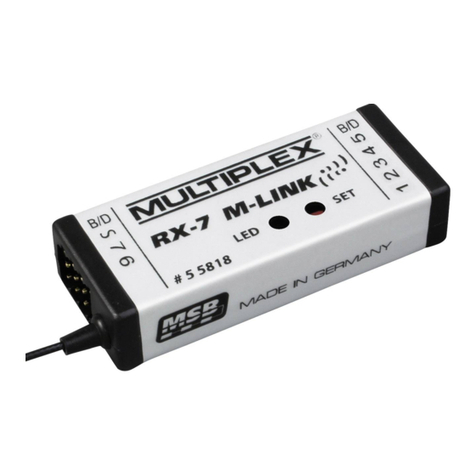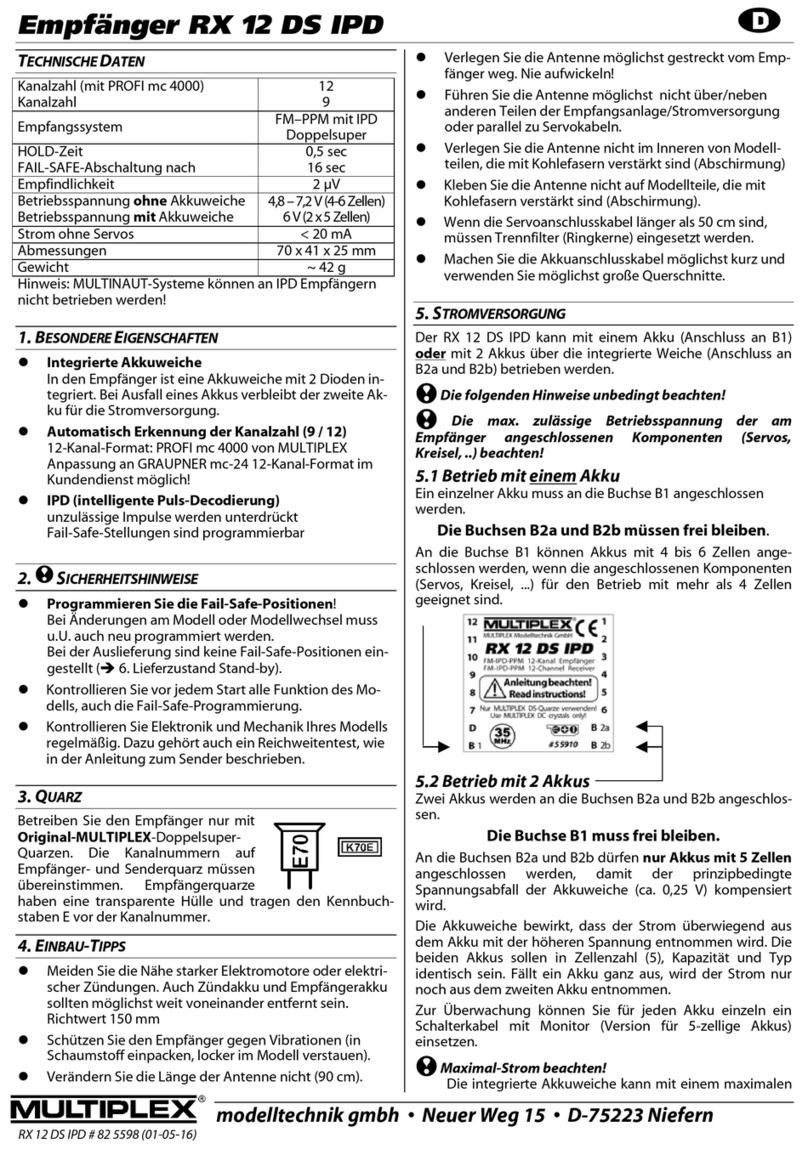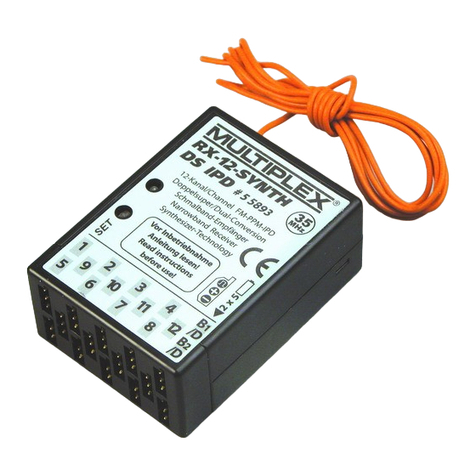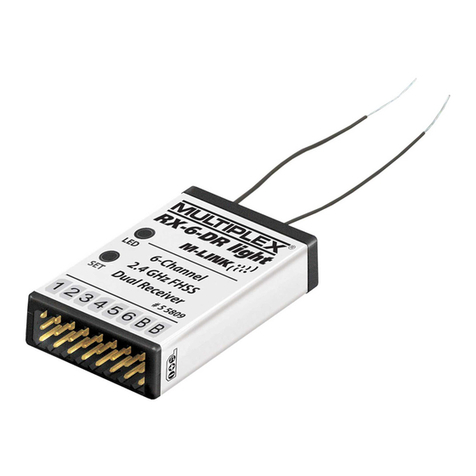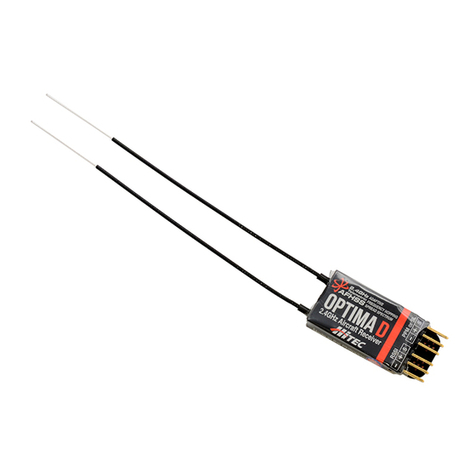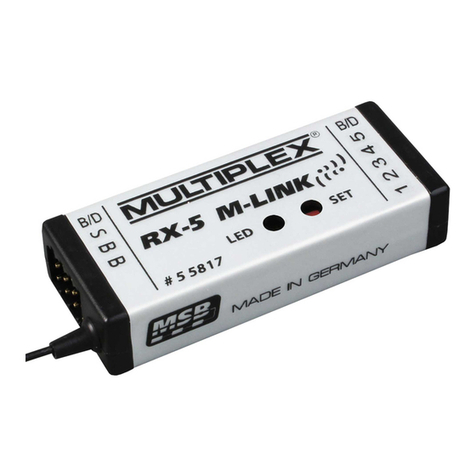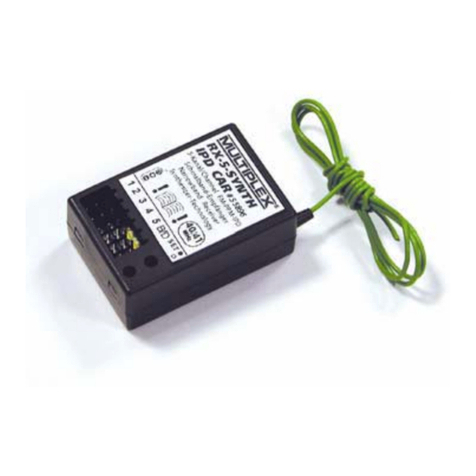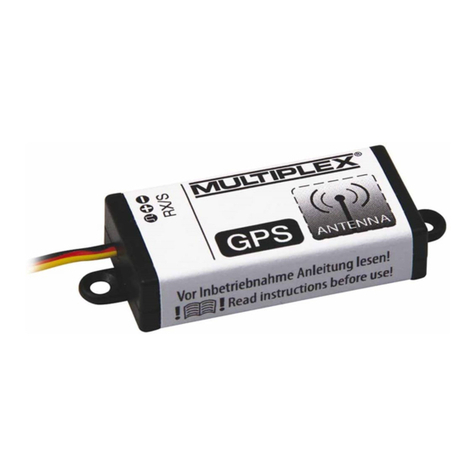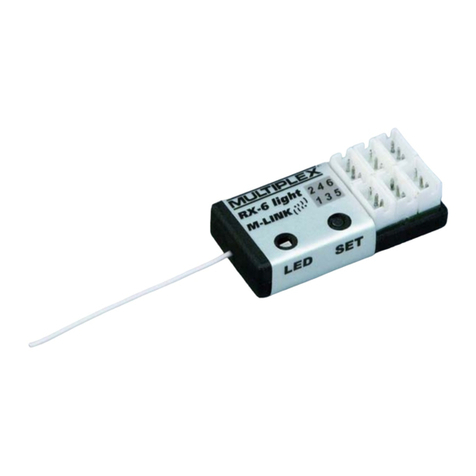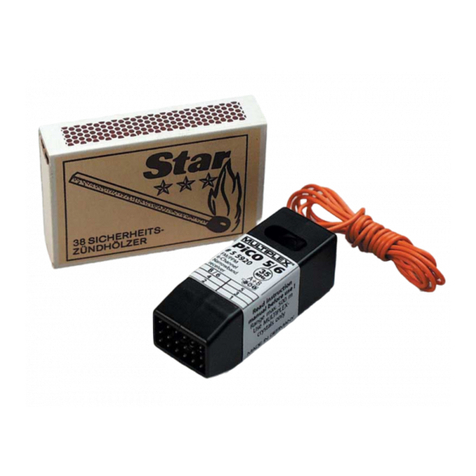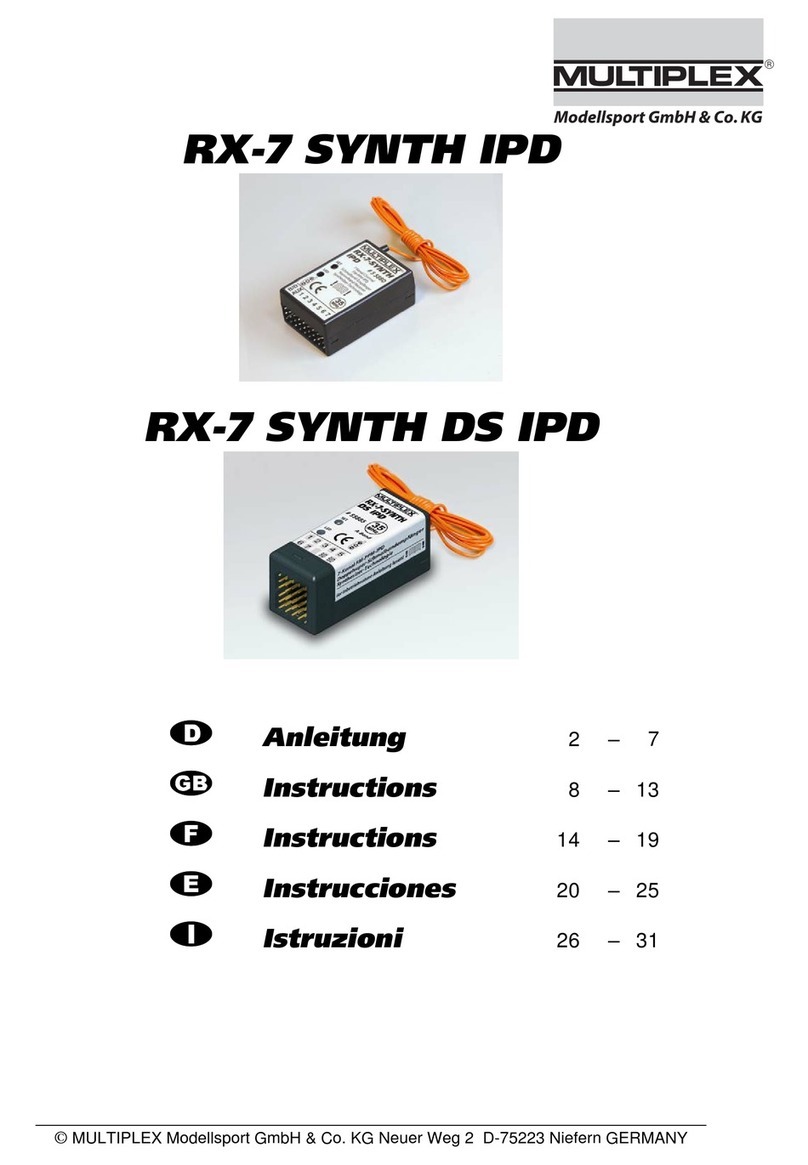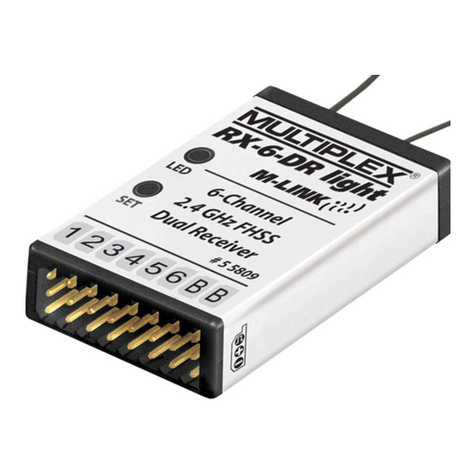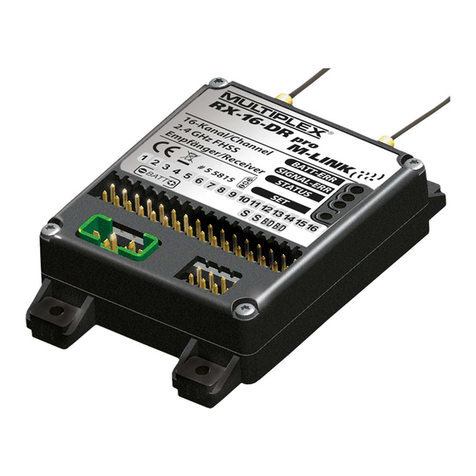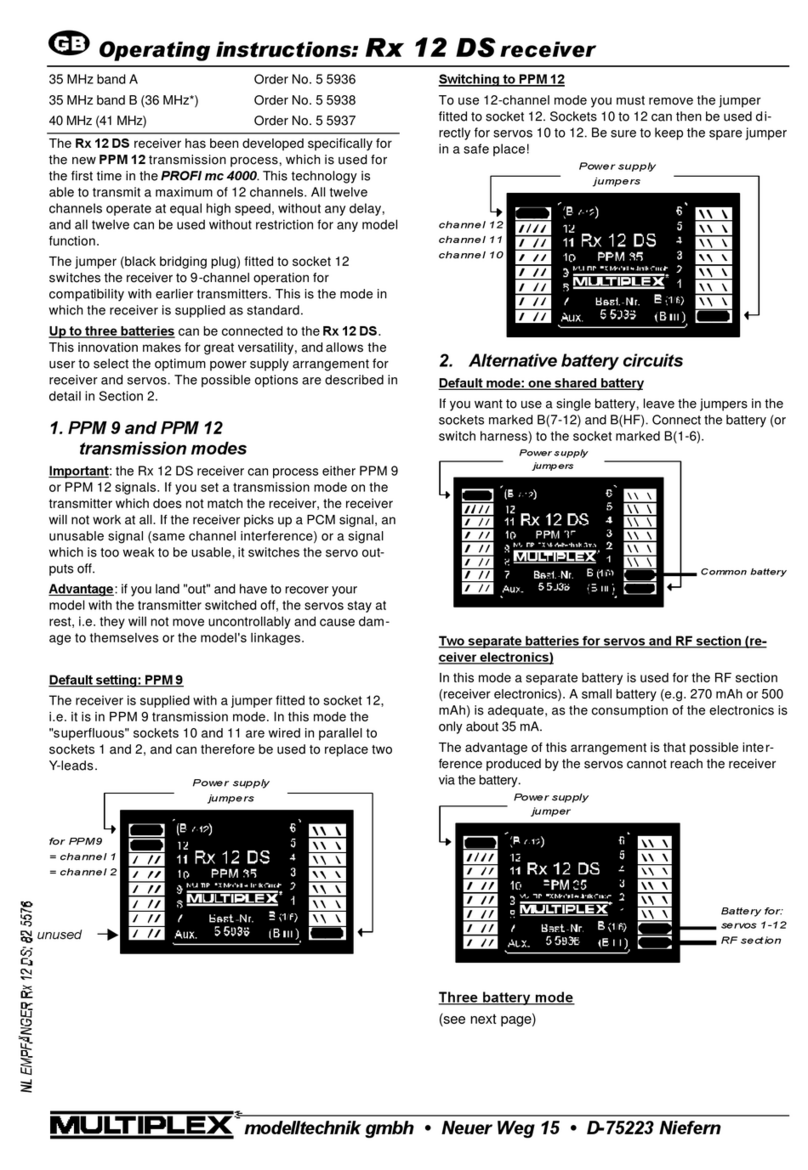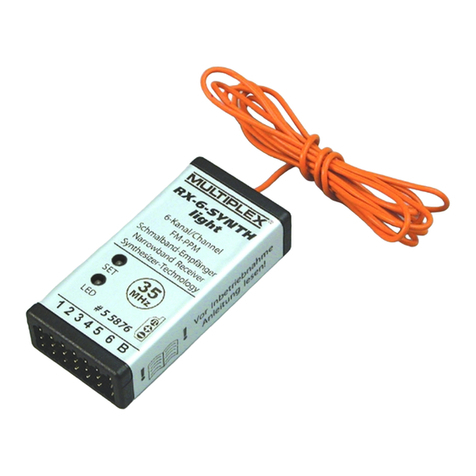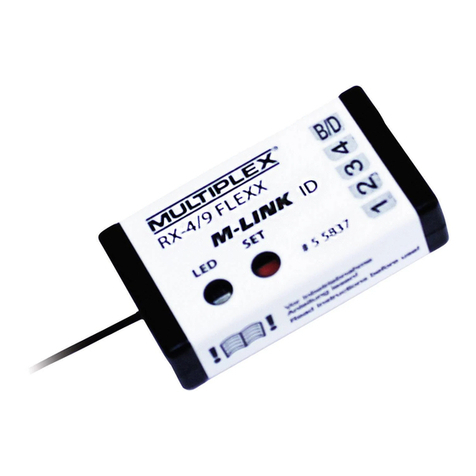
Operating Instructions
RX-5 slim M-LINK 2.4 GHz receiver
MULTIPLEX Modellsport GmbH & Co.KG • Westliche Gewerbestraße 1 • D-75015 Bretten (Gölshausen) • www.multiplex-rc.de Page 3/4
Instructions: RX-5 slim M-LINK 2.4 GHz receiver # 1-01194 LA 14.02.2019 • Errors and omissions accepted! •
MULTIPLEX
If you wish to disable FAIL-SAFE again, the receiver must be
reset to the default state (RESET 7.5
). After a RESET you
must repeat the binding procedure ( 7.2.1)!
! Note: always activate FAIL-SAFE!
For safety reasons we recommend that you always activate
FAIL-SAFE, and ensure that the selected FAIL-SAFE settings
will cause the model to take up as safe an attitude as possible
(e.g. motor idle / electric motor OFF, control surfaces neutral,
landing flaps deployed, tow-release open, …).
Selecting the FAIL-SAFE settings:
Use your transmitter to move all the servos (and the speed
controller) to the desired position. Hold the SET button pressed
in briefly (0.5 to 1 second). This stores the servo positions, and
the LED flashes to confirm this (LED code 5 7.1).
After sixteen seconds in FAIL-SAFE the receiver no longer
sends signals to the servos. Analogue servos and some digital
servos (see instructions) then become “soft”, to avoid them
being stalled. Modern speed controllers switch themselves off.
However, some digital servos remain “hard” and maintain their
last position.
FAIL-SAFE mode is automatically terminated as soon as the
receiver picks up valid signals again.
Testing the FAIL-SAFE positions:
Move the sticks to positions other than the FAIL-SAFE settings,
and then switch the transmitter OFF: the servos should go into
HOLD mode briefly (0.75 seconds), and then move to the FAIL-
SAFE positions which you previously selected.
The FAIL-SAFE positions must always be checked and updated
when necessary, e.g. when you install the receiver in a new
model.
! Checking the FAIL-SAFE function:
Never operate the receiver with the transmitter switched off for
longer than it takes to check the FAIL-SAFE function. Caution:
the motor could burst into life - injury hazard!
7.5 RESET to default settings
The receiver settings can be reset to the factory default values if
you wish. If you do this, please note that all your settings (e.g.
bound transmitter, FAIL-SAFE settings) will be lost.
Hold the SET button pressed in for at least ten seconds (as a
guide, the LED goes out when you press the button, comes on
again after two seconds, then off again after ten seconds).
When the RESET is complete, the receiver LED will flash to
confirm the action (LED code 5 7.1).
8. INSTALLATION NOTES
Locate the receiver at least 150 mm away from electric mo-
tors and any other electronic components such as speed
controllers for electric motors and drive batteries. Do not route
the aerial close to these components.
Install the receiver in the model in such a way that the aerial
is as far away as possible from any conductive material.
If the fuselage is made of conductive material (e.g. carbon
fibre), the aerial must be installed in such a way that its active
part (approx. the final 30 mm) is located outside the model.
Do not shorten the aerial or the aerial lead.
If your model requires a longer or shorter aerial lead, please
contact the MULTIPLEX Service Dept. or any MULTIPLEX
Service Centre.
Do not deploy the aerial parallel to servo leads, high-current
cables or electrically conductive components (e.g. pushrods).
Do not deploy the aerial inside or resting against model
components which are skinned or reinforced with conductive
material (metal foil, carbon fibre, metallic paints, ...), as they
can have a shielding effect.
Note the recommended installation scheme ( 15., sketches
A - C)!
High-current cables, e.g. those attached to the speed con-
troller, motor and flight battery, should be kept as short as
possible.
9. RANGE CHECKING
Regular range checks are very important - even when using a
2.4 GHz system - in order to ensure reliable operation of the
radio control system, and to enable you to detect sources of
interference in good time. This applies in particular:
Before the use of new or changed components, or existing
components in a new or modified arrangement.
Before re-using radio control system components which were
previously involved in a crash or a hard landing.
If you have encountered problems on a previous flight.
Important:
Always ask a second person to help you with your range
check, so that one of you can secure and observe the model.
If possible, carry out the range check when no other trans-
mitters are operating.
Carrying out the range check:
1. Select “Range check” mode on your transmitter (see the
operating instructions for the M-LINK transmitter or the
HFM3 M-LINK / HFM4 M-LINK / HFMx M-LINK 2.4 GHz RF
module).
2. The range of the RX-5 slim M-LINK receiver must be at least
forty metres with the transmitter set to low power. You have
reached the range limit when the servos start to move jerkily.
There must be line-of-sight contact between the transmitter
and the receiver aerial (i.e. the model) during the range
check.
Keep the transmitter and the model about one metre above
ground during the range check.
3. If your transmitter features an automatic servo test facility,
we recommend that you activate it for one control function
(e.g. rudder). This sets up a steady movement of the servo,
and enables you to detect the limit of range clearly.
Important:
Carry out the first range check with the motor switched off.
Turn the model in all directions and attitudes, and adjust the
aerial position if necessary.
For the second range check, run the motor at varying speeds
and check that the effective range is not significantly reduced.
If there is a marked reduction, locate and eliminate the cause
of the interference (caused by the motor, the arrangement of
the receiving system and power supply, vibration, etc.).

